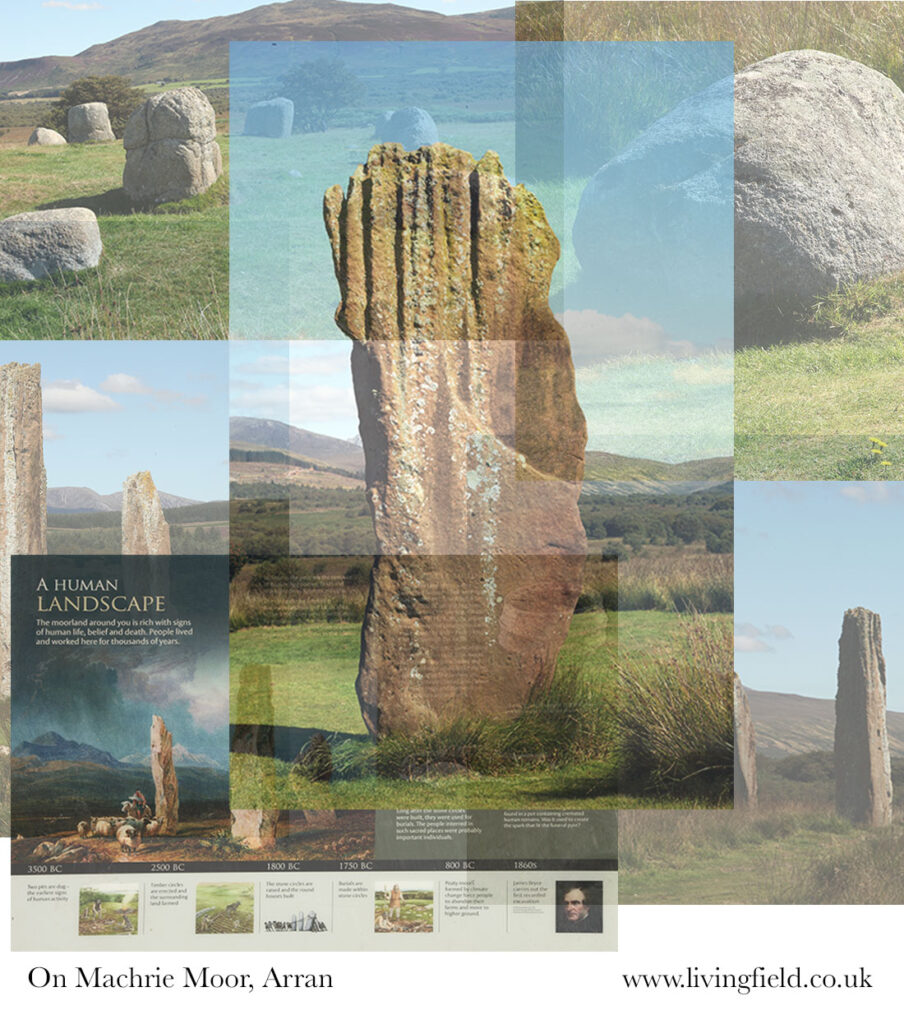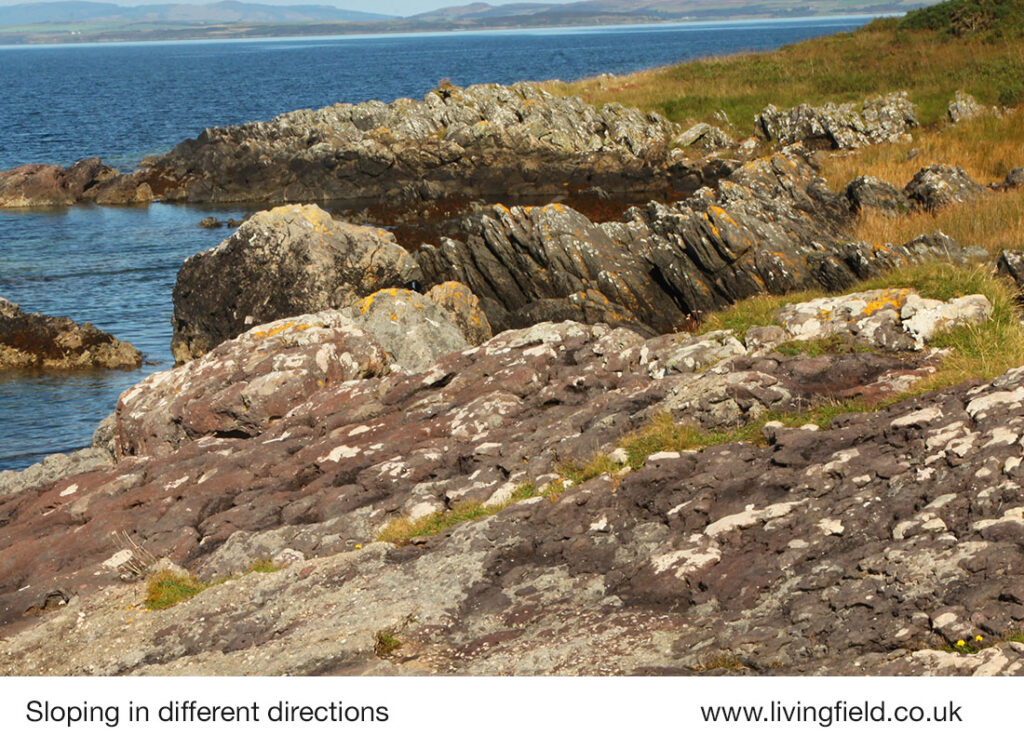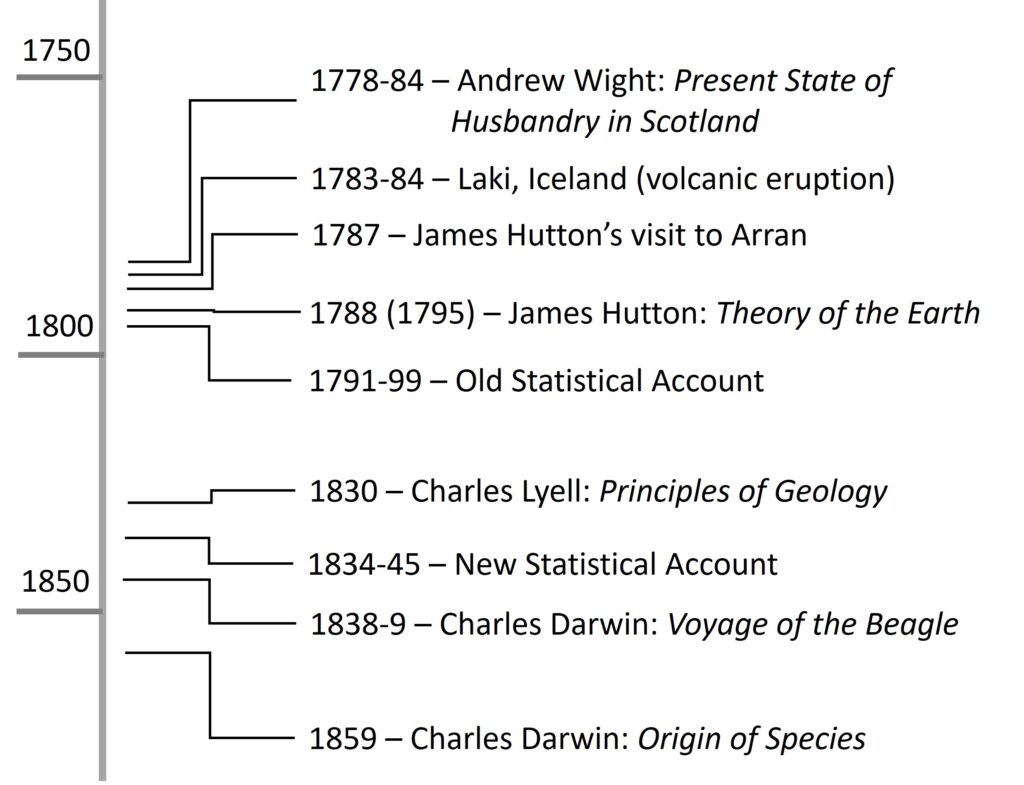The geologist James Hutton’s visit to Arran in 1787. His discovery of an Unconformity between two rock strata leading to new understanding of geological time.
The Isle of Arran has signs of an ancient past, both in its geology and its early civilisation. A visit in late August aimed to look at evidence of its post-glacial land use, specially in the Neolithic and Bronze Age. But its geology draws you in and leads you to the observations and inferences made by the geologist James Hutton over two centuries ago. Here, the Living Field muses on Hutton’s Unconformity. The stunning ritual landscape on Machrie Moor, and the agriculture that supported it, will be described later.

Hutton’s Unconformity in north Arran
The centre of the northern part of the Isle of Arran is made of granite, formed by volcanic activity, and since eroded by glaciers and weather into a series of sharp peaks, ridges and U-shaped valleys.
The nearby coastal fringes are not granite but a mix of mainly sedimentary rocks, and it was near the northernmost coastline that James Hutton discovered his Unconformity when he visited the island in 1787. (That’s more than 230 years ago!)

The detail and significance of the find are told at the information centres and web site of Arran Geopark [1] and in various books on Hutton [2]. Briefly, the Unconformity arises at the junction of two types of sedimentary rock: very old sandstone (350 million years) and even older schist (540 million years).

Both sandstone and schist were formed by compression of sediments layed down horizontally, but then contorted and eroded so that they are visible today at very different angles: the older schist rising steeply right to left (looking north in the photograph below) and the sandstone rising left to right but at a shallow angle.

Today the Unconformity is marked by a sign on a geological trail, but without its aid you could easily miss the junction of the schist and sandstone. Hutton was not previously aware of the phenomenon, but on seeing it, understood its significance. As the Walking Guide to the Arran Geopark [1] states: “He reasoned that such a structure must have taken millions of years to form. From his observations on Arran, Hutton concluded that the earth must be much older than previously thought, and introduced the concept of ‘deep time’ to the scientific community.”

On the seaward side of the geological unconformity was a botanical one – a small circular grove of green seaweed (Ulva intestinalis) within an extensive area of brown wrack, mainly Ascophyllum nodosum and several Fucus species. The cause was a freshwater stream running into the sea and de-salting the water enough for the Ulva.

James Hutton worked during a period of immense activity in science and technology. His publications pre-dated those of more famous scientists: for example, Theory of the Earth first appeared five decades before Charles Darwin went on his Voyage of the Beagle [3]. It was also a time when the earth reminded people of their fragility. The Laki eruption in Iceland, 1783-84, devastated crops and livestock, causing many to die of hunger, and made its presence felt much farther afield [4].
Hutton also practiced and wrote about farming and food production, contributing to the drive to restore soil fertility and raise agricultural output [2]. A few years before Laki, and Hutton’s visit to Arran, Andrew Wight began his definitive survey of agriculture in Scotland, which in time led to the first systematic inventory, the Old Statistical Account [5].

Sources | links
[1] Arran Geopark: information centres at Lochranza and Brodick, for self-guided walks, see Geopark Map & Leaflets.
[2] There are several books on the life and science of James Hutton (1726-1797), the following published with the aid of a grant from the James Hutton Foundation: McKirdy, Alan 2022 (1997) James Hutton the founder of modern Geology. National Museums Scotland.
[3] Charles Darwin’s Voyage and various editions of his books are described at Darwin Online.
[4] Laki volcano, Iceland. For a recent analysis: Dawson AG, Kirkbride MP, Cole H. 2021. Atmospheric effects in Scotland of the AD 1783-84 Laki eruption in Iceland. The Holocene 31, 830-843. Available online.
[5] Andrew Wight’s 1778-84 definitive survey of agriculture: Wight, A. 1778-1784. Present State of Husbandry in Scotland. Extracted from Reports made to the Commissioners of the Annexed Estates, and published by their authority. Edinburgh: William Creesh. Vol I, Vol II, Vol III Part I, Vol III Part II, Vol IV part I, Volume IV Part II – available online via Google Books. His work has been used many times on the Living Field web site, for example Great quantities of Aquavitae, The mill at Atholl, Gool rider gool rider, and articles in the Bere line. The Old and New Statistical Accounts are available online at The Statistical Accounts of Scotland 1791-1845.
The photographs and notes in this article were taken during the editor’s visit to Arran in late August 2022. Contact geoff.squire@hutton.ac.uk or geoff.squire@outlook.com
